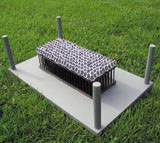Building a community
There will be provocative debate at the London Architecture Biennale, says Gareth Gardner, but what do pantomime cows have to do with it?

How intriguing. It’s the Saturday before the start of the London Architecture Biennale and festival director Peter Murray has asked me to meet him on the pavement of Clerkenwell’s St John Street.
When I arrive, something strange is kicking off. Respected architect Rab Bennetts is hopping around in his underwear and strapping a pillow to his stomach, while two pantomime cows with pendulous udders are chatting. Not surprisingly, traffic is slowing and pedestrians are staring. Murray – who runs local communications agency Wordsearch – explains that it’s a publicity stunt to promote the biennale, which launches this Saturday, 19 June. Bennetts is dressing up as a farmer and will lead the fake cattle towards Smithfield Market.
Cows figure prominently in the biennale programme, which has a Friesian’s head as its logo. This weekend, 1400m2 of St John Street will be turfed over and docile longhorn cattle trucked in from Wales to graze, hopefully joined by picnickers. Not only does it evoke the area’s history as a livestock market, but Murray hopes it will also inspire ideas of how a neglected streetscape could be transformed into an exciting public space.
The biennale, which runs alongside Architecture Week, was conceived to celebrate London’s architecture scene. In future years it will be held in different locations, but Clerkenwell was the natural choice for the inaugural festival, with its high density of design practices and rich history.
The turf is being laid in front of the Victorian Farmiloes Building, a former builders’ merchant, which has been requisitioned for the festival. It will host parties, debates and the main Urban Interventions exhibition, curated by Murray and infamous local resident Janet Street Porter, and designed by Project Orange. It features the work of more than 50 architectural practices with local connections. There’s a host of other events taking place throughout the area, including talks by Zaha Hadid and festival president Peter Ackroyd, walking tours, film screenings and building tours.
Although primarily focused on architecture, the festival should be of interest to designers of all disciplines, believes Murray. Not only does Clerkenwell have a rich history in printing, typesetting and graphics, but the festival will also emphasise the changing nature of the area and, in particular, the way gentrification has pushed designers progressively from Clerkenwell to Shoreditch and further east. The location du jour is London Fields, but how long before it’s Thames Gateway, muses Murray. ‘We will be asking, “How do you maintain areas like this for the creative industries that made them popular in the first place?”,’ he says.
In addition, there will be street furniture installations by designers – including Michael Marriott, Lolly Batty and Inflate. Final-year design students have also come up with seating for two Clerkenwell parks, in a scheme organised by Scarlet Projects, which also masterminded the publication of the free Clerkitecture guide to the district’s buildings. And 11 contract furniture showrooms will host exhibitions by local creatives that explore ways of transforming the
area, which despite all the regeneration, still has its less salubrious spots. It promises to be an exciting programme of events – but perhaps I’m biased, seeing as I live there.
The London Architecture Biennale runs from 19-28 June at various locations throughout Clerkenwell, London EC1. For information visit www.london biennale.org.uk
-
Post a comment




